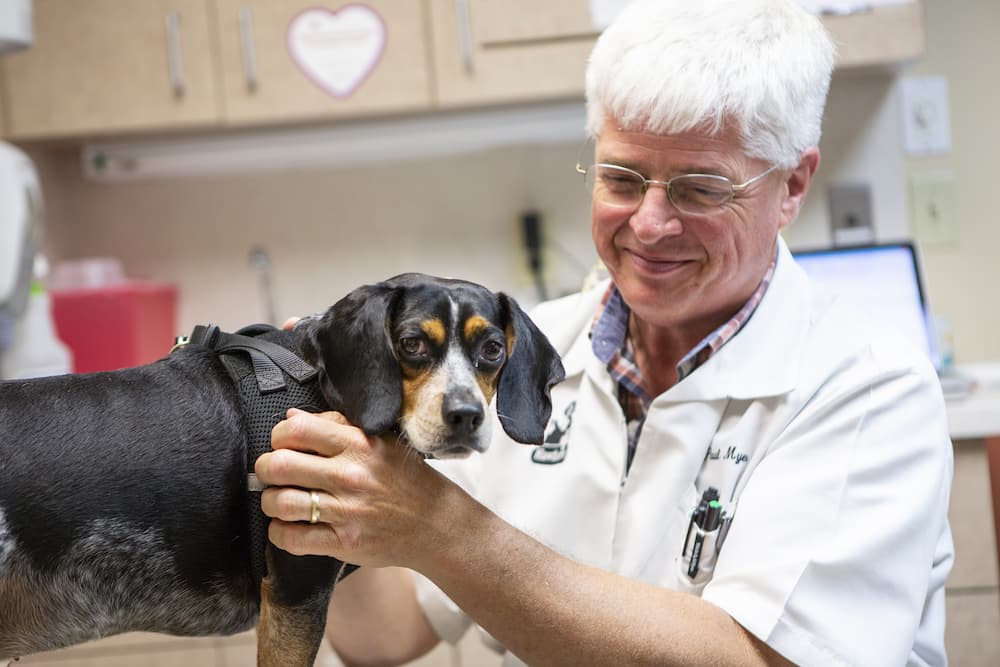After being cooped up inside this winter, people and their pets are quick to race outside to hit the walking trails or lounge around the yard the moment the sun comes out and the weather warms up.
Unfortunately, lurking in the trees, grass and puddles are microscopic predators ready to pounce and turn us and our furry friends into their all-you-can-eat buffets. While pests like fleas are more of an itchy inconvenience, others, like mosquitos, can be extremely dangerous – and even deadly – to our pet’s health by transmitting heartworms into their bloodstream. In fact, one in 200 dogs is infected with heartworm each year, but many owners don’t realize it until it’s too late.
By educating yourself on potential threats and protecting your pets against them, you can play outside all summer while staying safe all year long.
Why pet owners need to be vigilant
Our humid, muggy summers and close proximity to ponds and rivers make the Edwardsville region a beacon for hungry mosquitos, putting our pets at a greater risk for heartworm.
When a mosquito bites a mammal infected with heartworm, it becomes home to the heartworm’s offspring, which eventually grow into larvae. The moment that mosquito snacks on another dog or cat, the larvae are transmitted through the wound. Over the next year, they find their way into your pet’s heart where they mature and reproduce, and in turn, enlarge the heart and block blood flow.
In the early stages of infection, a pet may have an occasional cough. However, as the heartworms grow, a pet owner may notice severe symptoms, like breathing trouble, a persistent cough and a lack of energy, months later. By the time the warning signs do finally make their appearance, extreme and expensive measures have to be taken to save the pet’s life. Treatment includes a combination of antibiotics and injections over a minimum three-month period and costs pet owners thousands of dollars.
Prevention is the best medicine
Preventing heartworm is simple, painless and cost-effective. A variety of FDA-approved preventatives, including chewable oral tablets, topical liquid, or injections, are available at most veterinary clinics and range from just $10 to $30 a month.
Some heartworm preventatives also pull double duty by protecting your pet against fleas, which cause skin irritation, transmit tapeworms and spread like wildfire throughout your home. Simparica, for instance, kills adult fleas on your pet while Sentinel stops their life cycle, thwarting their reproduction. Any heartworm preventative should also be used in conjunction with an oral tick treatment to protect your pet from tick-borne diseases, like Lyme disease, Ehrlichiosis or Rocky Mountain Spotted Fever, as well as the skin irritation that can cause them to self-maim.
The biggest obstacle we see as veterinarians and vet techs when it comes to prevention is that many pet owners stop medication over the winter when the threat isn’t obvious or if they keep their dogs or cats indoors year-round. Depending on the species, mosquitos can actually sneak up on our pets even during the colder months, and over the summer, can easily slip through open doors or cracks in our attics. Fleas and ticks also find their way inside by hitching a ride on our shoes or clothing. Every month you don’t have your pet on a preventative is a month where they’re susceptible to these tiny terrors.
The time to get your pet on preventative is now. Your veterinarian will run a simple blood test to confirm your dog or cat is heartworm-free, and if so, will prescribe a medication that best suits their needs. If your pet is already infected, they will require a series of injections first as older larvae can survive preventative treatment. To learn more about protecting your pet this summer, contact the team at Hawthorne Animal Hospital at 618-288-3971.
